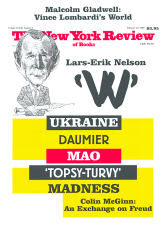Francis Haskell, who died on January 18 at the age of seventy-one, was one of the most important art historians of his time. He developed new ways of approaching the subject, and in doing so profoundly influenced the way in which we think about the art of the past. Throughout his career he avoided the most common and, until then, the most prestigious forms of art history, the study of the careers of individual artists and the exercise of connoisseurship. Instead, in his first and most famous book, Patrons and Painters, published in 1963, he explored the conditions in which Italian art was produced, from papal Rome in the early seventeenth century to Venice in the eighteenth, examining the motives of patrons and collectors, the changes in taste, and the growth of the art market. A masterpiece of social history and unprecedented in its range and scholarship, it provided a new perspective on two centuries of Italian art.
Haskell next turned his attention to the then-unfashionable official art of nineteenth-century France, and in his second major book, Rediscoveries in Art (1976), discussed the factors which led to changing ideas about the canon of great masters, from the outbreak of the French Revolution until the end of the nineteenth century. In Taste and the Antique (1981), written jointly with Nicholas Penny, he traced a complementary theme, the rise and fall in the prestige of classical sculpture. Having hitherto approached art from the perspective of a historian, in History and Its Images (1993) he shifted his focus to the ways in which art has influenced, sometimes constructively but more often misleadingly, historical interpretations of the past from the Renaissance to the present day. A final book, on the origins and development of art exhibitions, which have become so central to the modern experience of art, will be published shortly. Haskell’s own views about their growing importance were characteristically ambivalent, as he demonstrated in several memorable articles in The New York Review of Books.
Haskell’s studies of the social fac-tors which have affected the production and appreciation of European art since the Renaissance, always based on prodigious research and unencumbered by theoretical preconceptions, were free of the value judgments present, explicitly or otherwise, in so much art-historical writing. By showing the ways in which such judgments were historically conditioned, he inspired a much more sympathetic and unprejudiced appreciation of vast areas of Western painting and sculpture. He was able to do so not just because he thought as a historian but because of the breadth and openness of his taste and his astonishing familiarity with museums and monuments throughout the world, which he constantly revisited throughout his life. The spread of his ideas was also aided by the accessibility of his prose and the generosity of his tone, qualities no less evident in the lectures he delivered with equal fluency in English, French, and Italian.
Nothing better defines his approach than his verdict on the famous Italian art historian Roberto Longhi. What he admired above all in Longhi, he once said, was his ability to make historical connections. The remark would surprise most of Longhi’s many admirers and followers, since he is chiefly known today as a brilliantly eloquent critic and connoisseur, mainly preoccupied with the intense scrutiny of individual works of art. Haskell recognized that Longhi was also highly sensitive to the historical and social circumstances in which art was produced, even if he had little appetite or aptitude for investigating them. By contrast, Haskell himself took nothing for granted, and every work of art provoked him to ask fresh and productive historical questions. Thanks to his example, more traditional approaches have lost much of their credibility, and art history itself has become richer and less parochial as a result.
This Issue
February 24, 2000



